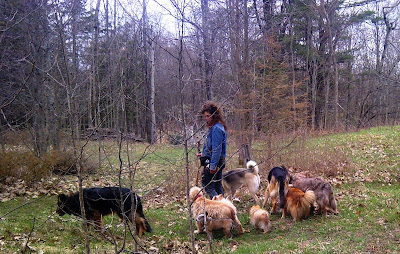Coach and Mentor Your Dog, Practice Mindfulness so You Can Be Your Dog's Pack Leader
Leadership Is
Being
that thing first that you want your dog to be, mindful:
- Attentive.
- Aware.
- Grounded.
- Patient.
- Respectful.
- Comfortable, confident and normal.
Observe
a dog interacting with another dog. Dogs that are psychologically well
balanced dogs - not anxious, reactive, fearful etc. A confident, well
socialized dog uses subtle means of communication to teach or correct
another dog. Most of what occurs is posturing primarily conveyed through
body language, although there may be verbalization at times. Have you
ever watched dogs playing and observed what happens when one dog is too
pushy with the other dog. The dog who objects to the pushy behavior
disengages from the play by calmly ceasing physical contact and turning
his/her head away from the other dog. this is leading by example. Calm,
patient , non-confrontational, logically directive and respectful - not
dominating, not unnecessarily intrusive, not aggressive.
Leadership Is Not
Leadership is not domination and has nothing to do with being an ‘Alpha’ - a much misunderstood, over-used and misused term. You should never aspire to being an 'alpha' to your dog - read why here. It is unfortunate that many veterinarians, trainers and people have adopted the false concept of the alpha dog.
The
starting point, the very core of teaching a dog to be a good dog is not
about habituating a dog to sit, stay or lie down. Teaching a dog to be a
good dog starts with educating the human about the true nature and
requirements of the dog. Dogs in their natural state are generally
'good'. Without intending to do so many humans take away a dog's ability
to fulfill themselves as a dog. This sets the stage for 'unhealthy' dog behavior.
When the human understands the basic principles of how to fulfill the
'dog in the dog', the human is in a better position to enable the best
in their dog and themselves.
Step One Training for the Human
- Be aware of what and how you communicate.
- Have a basic understanding of how dogs communicate.
Step Two - Basic Does and Don'ts
Common Mistakes Resulting From Lack of Mindfulness
Humans
require structure in their lives, so do dogs. In the absence of work, a
hobby, something productive to focus on, a goal(s) to keep wits sharp
and mind fulfilled a human becomes aimless, anxious, depressed...and so
it is for a dog. As a species we mentor our children - helping them to
cope with normal daily life situations - when this is done properly the
child becomes a grounded and confident being. Dogs require that same
mentoring.
Why do humans have so many rules and laws within their societies? To provide consistent, clear direction for the mass of humanity. Why is this necessary - well because most humans are not born leaders - they look to specific individuals to 'light and pave' the way. Given the opportunity most people will make decisions based on emotion and impulse - not logic. Inadequate training in strategic decision making gets people in trouble - and so it is for dogs as well. Most dogs are not born leaders - they are by natural disposition followers.
While some dogs are natural leaders, most are not and as such they look for leadership.
A dog requires an overarching structure in her life.
- Failure to recognize and control your own emotions.
- Not engaging in a working, logical mode.
- Engaging in emotive mode.
- Failing to provide a complete direction to your dog,
- Arguing, complaining rather than directing.
- For example: 'I wish you wouldn't do that', 'Oh, stop that' etc. There is a vast difference between complaining and instructing.
- Failure to stop.
- For example: if your dog is 'not behaving', 'not listening', stop what you are doing, don’t keep moving forward. Stop, direct your dog, then continue.
Step Three - Your Dog Needs Structure
Why do humans have so many rules and laws within their societies? To provide consistent, clear direction for the mass of humanity. Why is this necessary - well because most humans are not born leaders - they look to specific individuals to 'light and pave' the way. Given the opportunity most people will make decisions based on emotion and impulse - not logic. Inadequate training in strategic decision making gets people in trouble - and so it is for dogs as well. Most dogs are not born leaders - they are by natural disposition followers.
While some dogs are natural leaders, most are not and as such they look for leadership.
A dog requires an overarching structure in her life.
Within that broad structure, a framework for each and every situation in normal daily life. For example you should mindfully teach your dog should know what is expected of her in the following situations:
For example, how to exit from the house out the door and into the backyard:
The dog must go through a series of steps - psychological and physical to 'ask' permission and in this way the dog learns to connect and work with its human by navigating through a series of what I call 'gateways'. In so doing the dog knows that it will be provided with direction, that it will not be permitted to escalate to intense behaviour, that it must stop and think...
- Entering and exiting a door, room, etc.
- How to use the couch (sofa), your bed, etc. in a socially acceptable manner.
- How to take treats.
- How to wait for food and respect other's food.
- How to share toys and treats.
- How to get ready for a walk.
- How to great a human or another dog.
- How to play.
- etc.
For example, how to exit from the house out the door and into the backyard:
The dog must go through a series of steps - psychological and physical to 'ask' permission and in this way the dog learns to connect and work with its human by navigating through a series of what I call 'gateways'. In so doing the dog knows that it will be provided with direction, that it will not be permitted to escalate to intense behaviour, that it must stop and think...
- The dog should not be pressed up against the door, but instead should yield the space by the door and wait several feet away from the door.
- The dog should make eye-contact with its human.
- The dog should wait for the human to yield the space in-front of the door and/or wait for a gesture or signal that it may proceed out the door.
- The dog should be calm and attentive throughout this entire process.
Holistic Diet, Nutrition, Wellness Services Tailored to Your Individual Dog and Cat
For information about my holistic diet, nutrition and wellness services, visit my holistic wellness services page.
Maintain good health | Address acute and chronic health issues | Pre and post surgery support and recovery
My holistic wellness services are available worldwide via video consultation.
🌎 USA | Canada | UK | Europe | Australia | New Zealand | Asia | South and Central America | Africa | UAE
📱FaceTime | Facebook | Skype | WhatsApp
To set-up your holistic wellness consultation get in-touch via email, go to my contact me page.
Holistic Behavioral Services for Your Dog
For information about my holistic behavioral services, visit my holistic behavioral services page.
For dogs of all ages, sizes and breeds.
My behavioral services are available worldwide via video consultation.
🌎 USA | Canada | UK | Europe | Australia | New Zealand | Asia | South and Central America | Africa | UAE
📱FaceTime | Facebook | Skype | WhatsApp
To set-up your holistic behavioral session get in-touch via email, go to my contact me page.
Affiliations to Companies
✓ None.
✓ I don't sell food, supplements, or other products.
✓ I'm not aligned with any companies.
Article and graphics by Karen Rosenfeld.










